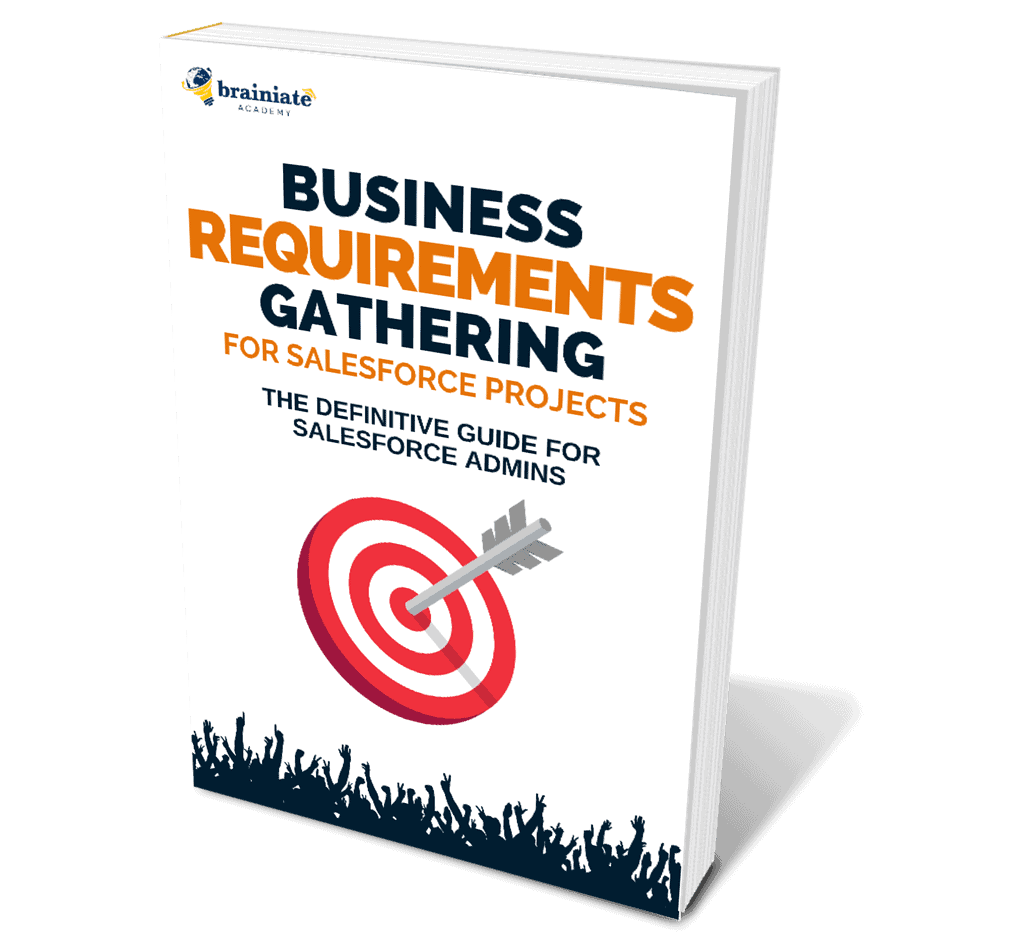Stop Wasting Time and Start Gathering Requirements the Right Way

Introduction
- Are you a Salesforce Admin who’s sick of spending hours just trying to gather requirements?
- Do you feel exhausted and frustrated with how your team approaches requirement gathering?
If so, it’s time to get more thoughtful about how you’re doing things.
In this blog post, we’ll dive into best practices for efficiently collecting business requirements to propel Salesforce projects forward quickly—and help make everyone on your team more productive!
Learn essential tips for crafting creative solutions that meet business needs faster and uncover insights along the way.
Take control of your time management and put your projects on the right track by implementing these essential strategies today.
🔥 SUBSCRIBE! 🔥

Get practical Salesforce advice in your inbox!
Feeling overwhelmed by everything you have to do as a Salesforce Admin?
I know how it feels.
I created the FREE Brainiate Newsletter – to help you stay up-to-date with the latest Salesforce news, advice, and product recommendations.
Sign up for my newsletter and get all that information right in your inbox – without having to search for it yourself. You’ll be able to focus on your projects with peace of mind, knowing you’re always up-to-date on the latest Salesforce updates.
Click the button below and sign up for my FREE Brainiate Newsletter today!

What Are Business Requirements, and Why Are They Essential to the Success of a Salesforce Project?
A business requirement is an explicit specification of what a business needs from a Salesforce project to be successful. It defines the project’s scope and must be considered when planning and executing it. Business requirements can include user stories, data points, necessary integration points, delegated access levels, or any other relevant details necessary for the project’s completion.
It is essential to gather and document business requirements before starting a Salesforce project to ensure that it meets all expected objectives. Clear-cut requirements will help point out potential issues before they become problems and allow Salesforce Admins to craft solutions more quickly and efficiently because they already understand what needs to be done. Additionally, having documented business requirements help keep everyone involved in the project on the same page since they can refer back to them throughout the process instead of relying on their interpretations.
Gathering comprehensive business requirements also provides insight into how stakeholders want their current systems and processes to work and any new features or functions they may want to be included in their Salesforce project. Furthermore, documenting these requirements allows for improved communication between team members by providing points that everyone can agree upon and use as a reference during meetings or discussions about the project’s progress. Finally, clear-cut business requirements outline guidelines for how tasks should be completed within a specific time frame so that nothing falls behind schedule during development.
5 Common Pain Points That Admins Experience When Gathering Business Requirements
Gathering business requirements as a Salesforce Admin is challenging and time-consuming; it requires Admins to take time away from essential tasks to understand the needs of their organization.
Some typical pain points Admins experience include:
1. Salesforce admins have limited time to gather business requirements
One of the most common pain points that Salesforce Admins face is a lack of time. This can be due to several factors, such as having too many other responsibilities, not being able to dedicate enough time to the task, or simply not having enough hours in the day. This lack of time can prevent Admins from effectively gathering requirements, leading to issues.
2. Stakeholders often resist the business requirements gathering process
Another common pain point is resistance from stakeholders. This can happen for various reasons, such as stakeholders not understanding the need for requirements gathering, feeling like their time is being wasted, or fearing that changes will be made that they disagree with. This resistance can make it difficult for Admins to get the information they need, leading to frustration.
3. Communication issues interfere with effective business requirements gathering
Another pain point that Admins often face is communication issues. This can include miscommunication between stakeholders and Admins, misunderstandings about what is being asked, or failure to communicate the requirements properly. These communication issues can make it challenging to gather accurate information and can often lead to frustration and wasted time.
4. It’s challenging to capture vast amounts of information when gathering business requirements
One of the challenges that Admins face when gathering business requirements is trying to capture vast amounts of information. This can be difficult because there is often a lot of information to take in, and it can be hard to know where to start or what is most important. Additionally, trying to capture all this information within a short timeframe can be daunting and may lead to Admins feeling overwhelmed.
5. Admins often have limited knowledge about the departments or processes involved
Another challenge that Salesforce Admins may face when gathering business requirements is having limited knowledge about the departments or processes involved. This lack of knowledge can make it challenging to understand what information is needed and how it should be gathered. Additionally, it may lead to Admins making assumptions about how things work, which could cause problems down the line.
6. Admins Don’t know how to prioritize requirements
A final pain point that Salesforce Admins may experience when gathering business requirements is not knowing how to prioritize requirements. This can be difficult because there are often many different stakeholders with different needs, and it can be hard to know which ones are more important or should be given more attention. Additionally, some requirements may conflict with others, making it even more challenging to prioritize them effectively.
SNAG THESE EMAIL TEMPLATES

200+ project management templates to help you get organized and increase your productivity!
Are you tired of wasting time writing the same email messages repeatedly?
I know your time is valuable, so I’ve created email templates specifically for Salesforce Admins to help you manage your Salesforce projects more efficiently.
Use these templates as a starting point or adapt them to fit your own needs. And you can cut and paste them into whatever email system you need.
Stop wasting time on menial tasks and start managing your projects more effectively.
Get access to a vast library of email templates to painlessly manage the entire project lifecycle!
Solutions to Make the Process Less Frustrating and More Efficient
1. How to deal with time restraints when gathering business requirements
The best way to address the problem of the limited time that Admins face when gathering business requirements is by adequately allocating the available time. This can be done by effectively using scheduling tools, such as Monday.com or Asana, which allow for greater visibility into the amount of time allocated and used for each task. Furthermore, having clear expectations and goals set at the outset can also ensure that tasks are completed on schedule.
Admins should also use standard templates for collecting requirements, allowing them to quickly and easily gather stakeholder information. They should also consider conducting interviews with key stakeholders to understand their needs and objectives. By doing so, they can better assess what needs to be done to meet those objectives. Additionally, establishing a communication plan between the Admins and stakeholders can help ensure all parties are on the same page throughout gathering requirements.
Finally, delegating responsibilities among team members can let Admins focus on gathering requirements without being overwhelmed by other tasks. Collaboration tools such as Slack or Teams can help facilitate collaboration while reducing administrative overhead. By involving team members in decision-making processes related to requirements gathering, project managers will have an easier time ensuring that all necessary information is collected promptly.
2. How to deal with resistance from stakeholders
One of the most effective ways to address stakeholder resistance to the business requirements-gathering process is through effective communication and education. Admins need to explain in detail why gathering requirements is essential for the success of their project, especially if stakeholders perceive it as a waste of time or unnecessary. They should also emphasize how their input will be used and valued throughout the process.
In addition to communicating the need for requirement gathering, it can be helpful for Admins to involve stakeholders in the process by allowing them to provide feedback and make suggestions for changes or improvements that could be made. This helps create a sense of buy-in from stakeholders and ensures their concerns are addressed during each step. Furthermore, regular communication between stakeholders and Admins should be encouraged during each phase of the project to ensure everyone is on the same page regarding progress and timelines.
Lastly, Admins need to manage expectations concerning timeline and budget goals. Stakeholders should be aware that any changes they suggest may require additional time and money, so it is essential to set realistic expectations. This can help reduce frustration when issues arise during later stages of development due to time or cost constraints. By addressing these issues early on, they can ensure that their business requirements-gathering process runs smoothly and achieves its desired outcome.
3. How to avoid communication issues from hurting your business requirements gathering process
To address the problem of communication issues interfering with effective business requirements gathering, Admins must create and maintain a clear line of communication between stakeholders and themselves. This can be done through regular meetings, emails, phone calls, or other forms of communication. Additionally, Admins should ensure that all parties understand their roles in the requirements-gathering process and know the expectations for each step.
Clear communication can also help Admins identify misunderstandings about what is being asked or ensure that all requirements are adequately communicated. To do this, Admins should take the time to explain the purpose behind each requirement and ask questions if there is confusion. Additionally, they should provide examples or illustrations when needed to give stakeholders a better understanding of what is being asked of them.
Admins must also strive to create an environment where open dialogue is encouraged between all parties involved in the requirements-gathering process. This will help foster a better understanding between stakeholders and Admins while allowing both groups to express their concerns and ideas more freely. Additionally, feedback from both sides should be welcomed to refine further and improve existing processes or protocols for gathering requirements.
Finally, Admins should document any agreements reached during the requirements-gathering process so that all parties can record what has been discussed and agreed upon. This documentation can be a reference point if any questions arise or changes need to be made. By creating clear lines of communication and documentation throughout the process, Admins can ensure that accurate information is gathered without wasting valuable time due to miscommunication issues.
4. How to manage the vast information overflow when gathering business requirements
One way to address the challenge of capturing vast amounts of information when gathering business requirements is to break down the task into smaller, more manageable components. For example, rather than trying to capture all the data at once, the Admin can focus on collecting a few key pieces of information and then move on to another area. This will allow them to focus on one aspect at a time instead of feeling overwhelmed by the sheer amount of information. Additionally, Admins must ensure that they have adequate resources available to understand and process each piece of information properly. This could include additional personnel or software tools to analyze and interpret data.
Admins should also look at ways they can simplify their data collection processes to make it easier for them to capture relevant information quickly. For instance, they could develop templates or outlines that help guide their data collection efforts while ensuring they are collecting all essential components. Furthermore, Admins could also create checklists that outline what types of data need to be gathered and how they should be collected. This will help them stay organized and ensure they are not missing any critical details during the requirements-gathering process.
Finally, Admins should take advantage of technology when possible, as this can help speed up the data collection process considerably. Automated systems such as artificial intelligence (AI) can help gather large volumes of data quickly without needing human input every step of the way. Similarly, natural language processing (NLP) can easily extract relevant pieces of unstructured text from large documents, saving Admins considerable time when gathering business requirements.
5. How to address limited knowledge about other departments or processes
One way to address the challenge of having limited knowledge about the departments or processes involved is to take a collaborative approach. This means involving representatives from each department impacted by the Salesforce implementation. They can help provide insight and input into what information needs to be gathered and how it should be used. Additionally, they can ensure that there is an understanding of the business processes and procedures in place so that they can be appropriately taken into account during development.
Consult with experienced external partners who understand Salesforce best practices and have experience in developing solutions for similar companies or contexts. These external partners can offer valuable advice when setting up your Salesforce environment, helping you identify areas where extra attention or customization may be needed.
Finally, it’s crucial to spend enough time upfront collecting detailed business requirements from all affected departments and stakeholders. Having precise requirements from each party helps reduce misinterpretations later on. It also allows Admins to think through potential challenges ahead of time to develop a solution that meets everyone’s needs.
Ultimately, understanding the different departments, processes, and stakeholders involved in a Salesforce implementation is essential for setting up a thriving environment. Taking a collaborative approach, consulting with experts, and taking the time upfront to collect detailed business requirements are all critical steps toward achieving this goal.
6. How to prioritize business requirements
To address the problem of not knowing how to prioritize requirements, Salesforce Admins should create a process for collecting and assessing business requirements. This should include gathering input from all stakeholders involved and asking questions that will help identify what their needs are and how they prioritize them. Additionally, the Admin should create a document that outlines each requirement in detail, including any potential conflicts or trade-offs.
Once all the requirements have been gathered, the Admin can begin to prioritize them by assessing the impact each one would have on achieving the desired outcome. The impact could be measured in terms of time, cost savings, customer satisfaction, or other metrics. They should also consider which requirements are more urgent or necessary for meeting deadlines. After prioritizing the requirements based on these criteria, the Admin can plan out how to best implement them in order of priority.
Finally, it is essential for Salesforce Admins to continually review and assess their prioritization process and the results of their decisions to ensure they are staying on track with achieving their desired outcome. This can also help identify missed opportunities or areas needing further review or adjustment before moving on to other requirements or tasks.
SNAG THESE FREE RESOURCES!

Struggling to Manage Your Salesforce Projects?
Master Project Management With Our Expert Resources for Salesforce Admins.
Check out some of these FREE RESOURCES, templates, ebooks, and courses to take your project management skills to the next level and take control of your Salesforce career!
5 Tips to Ensure Stakeholders Are Engaged in the Business Requirements Gathering Process
1. Understand the business needs
Salesforce Admins must clearly understand what information is required from stakeholders to ensure that all requirements are met. This may involve researching industry trends, customer feedback, existing processes, etc.
2. Establish communication channels
Establishing proper communication channels, such as phone calls or emails, is essential for smooth collaboration between Salesforce Admins and stakeholders. This will help clarify the requirements, share the needed documents, and accurately discuss the project timeline.
3. Speak the same language
Salesforce Admins need to communicate with stakeholders using a common language they can both understand to capture their needs and expectations regarding the Salesforce project adequately.
4. Engage with stakeholders
Salesforce Admins must engage with stakeholders by keeping them updated on progress reports and scheduling regular meetings to ask questions and finalize project details. This will build trust and ensure accuracy in gathering business requirements.
5. Capture accurate data
To ensure that the data gathered from stakeholders is accurate and up-to-date, Salesforce Admins must be aware of current industry trends and use automated systems or tools that can automate tasks like capturing customer inputs or generating reports quickly without errors.
DOWNLOAD YOUR COPY!

The quick-start guide to gathering business requirements
Are you responsible for ensuring Salesforce projects run as smoothly as possible?
With the Business Requirements Gathering for Salesforce Projects: The Definitive Guide for Salesforce Admins, you can quickly get up to speed on the best practices for gathering business requirements.
This comprehensive book, written by Salesforce consultant and trainer David Giller, provides powerful methods and insights to ensure your projects are successful.
Conclusion
As Salesforce Admins, gathering business requirements doesn’t have to be a laborious process. Following the tips and best practices outlined in this blog post, you can streamline your workflow and ensure you’re gathering all the essential information needed to move forward with an implementation or project.
Resources like templates, user interviews, and surveys can make understanding customer needs more accessible and efficient. Developing a good relationship with stakeholders is also key – they’ll have invaluable knowledge about the business that can help guide your processes.
Finally, don’t forget to involve other departments in the process; they may have unique perspectives that can be incredibly helpful in crafting a successful solution. With these tools, Salesforce Admins can quickly and efficiently gather business requirements, allowing them to focus on what matters: delivering value for their organizations.






